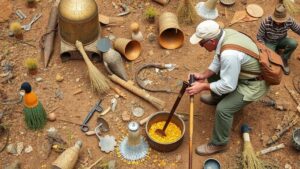How to Detect Along Ancient Riverbeds Buried Under Modern Soil Layers
How to Detect Ancient Riverbeds Buried Under Modern Soil Layers
Identifying ancient riverbeds concealed beneath modern soil layers is a pivotal aspect of geoscience and archaeology. These buried formations often contain crucial information about past environments, climate changes, and human activity. Researchers employ a range of methods and technologies to discern these ancient features, which can yield important insights into our planets history. This article presents a comprehensive overview of the techniques utilized in detecting ancient riverbeds, grounding the discussion in academic research and real-world applications.
Understanding Ancient Riverbeds
Ancient riverbeds, or paleochannels, are geological formations created by rivers that have shifted course over millennia. The study of these riverbeds is fundamental to understanding sedimentary processes and landscape evolution. Such submerged landscapes offer a snapshot of historical water flow patterns, vegetation cover, and even human interactions with the environment.
For example, the meandering patterns of old river courses can reveal how climatic conditions influenced water availability and the migration of early civilizations. Mississippi River in the United States presents a prime example, having shifted its course many times over the last several thousand years, leaving behind numerous buried channels.
Geophysical Survey Techniques
Geophysical survey techniques provide non-invasive methods to explore subsurface structures and are especially effective in locating ancient riverbeds. Key methods include:
- Ground Penetrating Radar (GPR): This technique utilizes radar pulses to image the subsurface. High-frequency radio waves are transmitted into the ground and reflect off different materials, allowing researchers to visualize changes in soil and sediment layers. GPR has been successfully used to map ancient river channels in places like the Great Plains of North America.
- Electrical Resistivity Tomography (ERT): ERT measures the electrical resistance of underground materials. Wet sediments from ancient riverbeds exhibit different resistivity compared to surrounding dry soil. For example, a study conducted in the Netherlands using ERT identified buried river channels by analyzing the electrical properties of the soil.
- Magnetometry: This technique detects variations in the Earths magnetic field caused by the presence of different geological materials. It has been effectively used in sites like the prehistoric landscapes of the UK, where ancient river systems have left magnetic signatures in the soil.
Soil Core Samples
Soil core sampling is another method employed to study ancient riverbeds. By extracting vertical columns of soil, researchers can analyze stratigraphy, or the layering of soil types, which reveals historical data about sediment deposition and erosion. The presence of specific sediment types, such as alluvial deposits, can indicate past river activity.
For example, in Egypt, soil cores taken from areas near the Nile have shown distinct layers corresponding to river flooding events, allowing researchers to correlate these with archaeological findings from early Egyptian civilizations along the rivers banks.
Remote Sensing Technologies
Remote sensing involves the use of satellite imagery and aerial photographs to detect landscape features suggestive of ancient river systems. Changes in vegetation patterns, soil moisture, and topography can hint at underlying riverbed structures. Technologies such as LiDAR (Light Detection and Ranging) have revolutionized the field by producing high-resolution topographic maps that can expose subtle differences in landforms.
In South America, for example, LiDAR has been utilized to uncover features associated with ancient water systems in the Amazon rainforest, identifying previously unknown channels and settlements once thought lost to time.
Multidisciplinary Approaches
The detection of ancient riverbeds benefits significantly from a multidisciplinary approach combining geology, geography, and archaeology. Collaborations between scientists in these fields yield broader perspectives and more robust findings. Adopting a holistic view towards analysis allows for contextualizing the scientific data within historical frameworks, further enriching our understanding.
For example, a recent project involving sediment analysis and historical research in the Indus Valley provided insights into how ancient water management practices shaped early urban centers, thereby illustrating the interplay between ancient river behavior and human innovation.
Challenges in Detection
Despite advancements in technology and methodologies, certain challenges remain in detecting ancient riverbeds. These include:
- Soil Disturbance: Modern agricultural practices can disrupt soil layers, making it difficult to interpret cores or geophysical surveys accurately.
- Overlapping Features: In some regions, ancient riverbeds may be obscured by subsequent geological or human activity, creating complex layering that is hard to decipher.
Addressing these challenges often requires integrating multiple detection methods and long-term research strategies that account for both historic and current environmental processes.
Conclusion
Detecting ancient riverbeds buried under modern soil layers is a complex but rewarding endeavor essential for understanding past ecosystems and human behavior. Through the application of geophysical techniques, soil sampling, remote sensing, and interdisciplinary collaboration, researchers can uncover valuable insights into our planets history. ongoing refinement of these methods continues to enhance our ability to explore and interpret these fascinating remnants of Earths geological past.
For those interested in pursuing this field, the key takeaways include staying abreast of technological advancements, refining methodologies, and embracing collaborative research approaches that yield a comprehensive understanding of the ancient waterways that once shaped our landscapes.



